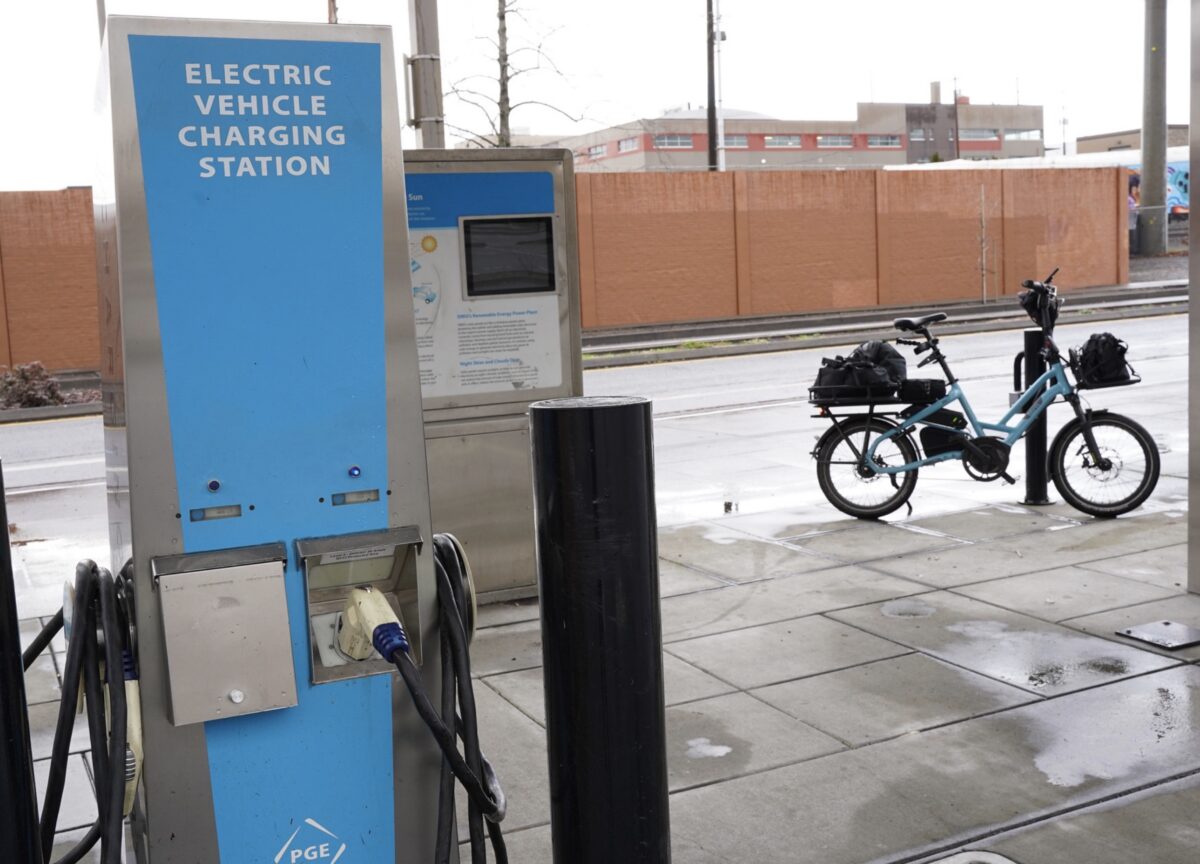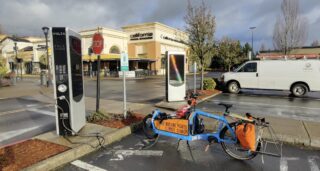
(Photo: Jonathan Maus/BikePortland)
Within the $1.2 billion chunk of change the state of Oregon received from President Biden’s Infrastructure Investment and Jobs Act, (IIJA) $52 million has been designated for electric car charging stations. More funds will be provided for this program through state sources. In total, the Oregon Department of Transportation (ODOT) is committing $100 million over the next five years for electric vehicle charging.
“The Feds set the funding, and they want e-cars.”
— Jillian DiMedio, ODOT
We’re watching closely to see how much — if any — of that money will go toward electric bicycle charging.
The term “electric vehicle” (EV) typically refers only to electric cars, but bicycles are vehicles under Oregon law and if we want to reach the full potential of transportation electrification and bring the benefits of bicycling to more people in the process, we must expand our definition of EVs.
Based on a statement from ODOT released this week, they’re beginning to see the light. In their announcement about the $100 million commitment, the agency said they’re not “ignoring other types of electric vehicles.” “Micromobility (bicycles and scooters) are also going electric… and ODOT will explore opportunities to add micromobility charging,” the press release reads.
When it comes to how they’ll explore these opportunities however, the details are murky. ODOT has a clear game plan for how they’re going to dole out the money to build an electric car charging network; less so for the plan to make sure people can charge their e-bikes and other micromobility devices while out and about.
This is partially because much of red tape around the IIJA funding and the federal government’s requirements to specifically fund electric car charging says ODOT’s Senior Transportation Electrification Analyst Jillian DiMedio. “The Feds set the funding, and they want e-cars especially,” she shared with me in a conversation this morning.
Advertisement
But the focus on electric cars isn’t solely because of federal requirements. The ODOT press release states that the $100 million investment will be focused on cars, SUVs and trucks because “demand is high and the technology is mature.” This statement is sure to ruffle some e-bike enthusiast feathers, considering e-bike demand is actually surpassing that of electric cars, and e-bikes have been around longer than the first modern electric cars.
DiMedio says another reason e-bike charging is lagging is because while access to charging stations is crucial to get around on an e-bike, a lack of public outlets hasn’t been shown to be one of the main barriers to adoption.
“We’re really committed to learning more about this industry, and we want to understand what the key barriers are and the recommended strategies for overcoming them,” DiMedio says. Instead of finding a place to recharge, DiMedio thinks bigger adoption hurdles for would-be e-bikers are safety concerns and cost.
We’ve acknowledged this in our reporting on what’s holding back the e-bike boom, but a lack of public demand for e-bike charging needs shouldn’t be the only data point when the EV charging conversation has never fully welcomed bikes into the mix. If ODOT invests in charging for EVs, they need to be inclusive of more than just cars.

“We recognize electric micromobility as one of our use cases. They really can replace car trips,” DiMedio says. “And education and awareness are a huge part of this. People don’t recognize the capacity.”
As it is now, ODOT is working with private company Electric Vehicle Charging Solutions on upgrades to the charging stations along the West Coast Electric Highway, and these upgrades will include installing new 120 volt outlets for electric bikes and scooters.
DiMedio says they’re also working with Forth on a study about micromobility needs. The last ODOT electrification study didn’t give e-bikes their due, so hopefully this new study will be more insightful into how better to serve e-bike users.
Ultimately, DiMedio says they want to be working from all sides. “Our goal is to electrify everything that moves,” she says.
